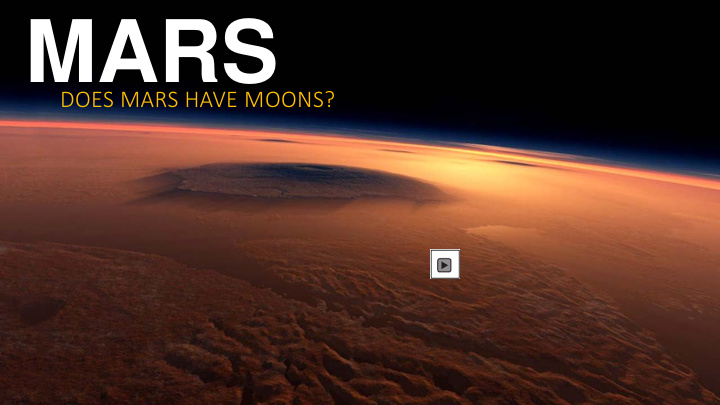



MARS DOES MARS HAVE MOONS? Mars’ Moons Phobos and Deimos
THE DISCOVERY OF MARS’ MOONS • Discovered by American astronomer Asaph Hall • First found Deimos August 12 th 1877 • then Phobos August 18 th 1877
GREEK NAMES • Named after the mythological sons of Ares who was the Greek counterpart to Mars, the Roman God of War • Phobos means fear • Deimos means flight (as in: to flea, or run away) Not to scale
INTRODUCTION • Diameter= 22km • Diameter= 13km • Orbit= 8 hours • Orbit= 30 hours • Distance from Mars= 9 376 km • Distance from Mars= 20 069 km PHOBOS DEIMOS
COMPOSITION AND FEATURES • Primarily carbon-rich rock • Mixed with ice deposits • Similar composition to asteroids in outer asteroid belt of solar system • Surfaces are covered in craters, dust and loose rock • Smallest moons in solar system • Not large enough to become spherical • Look like space potatoes!
FORMATION THEORIES • 3 competing theories of formation: 1. Asteroids were pulled into Mars’ Orbit 2. Asteroid crashed into Mars and material released came together to form moons 3. Asteroid crashed into a once larger moon splitting it in two
STARTING AS ASTEROIDS This theory involves the capture of passing asteroids.
FOR AND AGAINST THEORY SUPPORTING EVIDENCE DISPROVING EVIDENCE • Composition of moons is very • Phobos and Deimos have very similar to asteroids circular orbits, whereas captured bodies usually have elliptical orbits • Atmosphere of early Mars could have settled the asteroids into • Atmosphere may not have been more circular, controlled orbits significant enough to change orbits • Irregular shapes consistent with asteroids
VIOLENT BIRTH LIKE EARTH’S MOON In this theory, it is believed that an asteroid impacted with Mars causing debris from the surface to be ejected from the planet. Once in space, the debris would have joined together to form Phobos and Deimos.
FOR AND AGAINST THEORY SUPPORTING EVIDENCE DISPROVING EVIDENCE • Moons have seemingly different • Late Heavy Bombardment composition to Mars to be product period of solar system led to of its debris (density of moons is many such collisions much lower)
LUNAR ASTEROID COLLISION Asteroid impact with large moon, breaking it into two smaller moon, Phobos and Deimos.
FOR AND AGAINST THEORY SUPPORTING EVIDENCE DISPROVING EVIDENCE • Again, Late Heavy Bombardment • Asteroid big enough to separate means such collisions were a moon would be more likely to common in Mars’ early history crush it into small pieces, 2 sizeable bodies capable of • Moons have similar becoming moons is unlikely compositions
EXPLORATION OF MARS’ MOONS • Timeline of Missions to observe Phobos and Deimos
DETAILED TIMELINE Mariner 9 Viking Orbiters Phobos 2 Mission Mars Global Surveyor
FUTURE MISSIONS FOR PHOBOS AND DEIMOS • Scientists have considered using Phobos as a base for astronauts to observe the Martian surface • This could be useful as the camp would be protected from Sun’s harmful radiation 2/3 of every orbit • Mars would act like a shield from cosmic rays
Recommend
More recommend